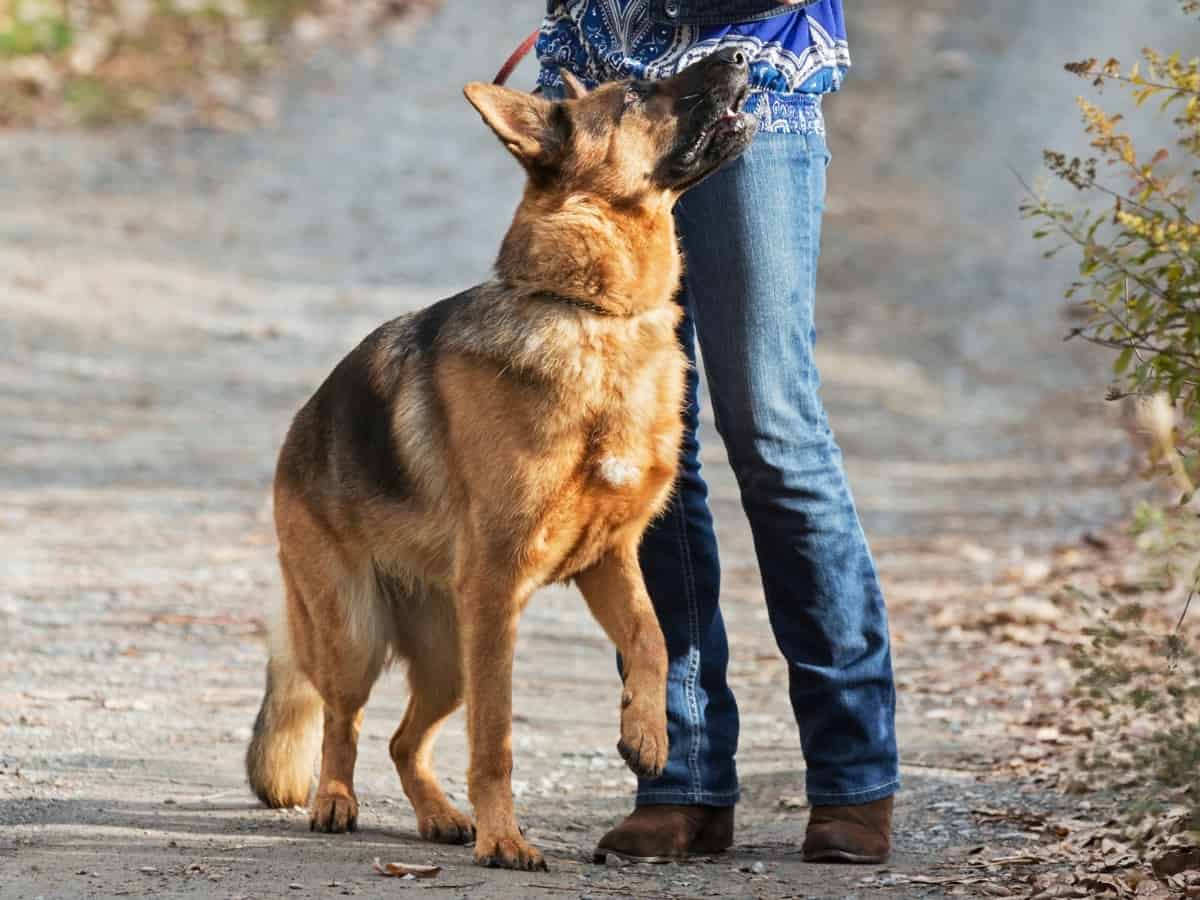Walking a German Shepherd with a collar and leash can be uncomfortable for the dog and harmful to its spine and neck health. GSDs are large dogs, and pulling the leash can choke them. It is much better to use a front clip harness or train your dog to walk alongside you or “heel.”
But how do you train a German Shepherd to heel?
Here’s how to train a German Shepherd to heel in 6 simple steps:
- Start while your German Shepherd is sitting.
- Stand next to your dog and say, “HEEL.”
- Tap your thigh to guide your dog.
- Reward him for following the command.
- Use a harness if the dog fails and try again.
- Induce the heel position while you stand away.
This article will teach you everything you need to know about getting your German Shepherd to heel on command. The tips in this post can individually help your German Shepherd get better at heeling but ideally build on top of each other and form a chronological plan.

1. Start When Your GSD Is Sitting
The first step in teaching your German Shepherd to heel is to start when he is sitting.
Here’s how:
- While your GSD is sitting, position yourself next to him as if he were heeling, and you stopped during a walk.
- The dog will walk to maintain said proximity when the word “HEEL” is associated with this position.
- It is essential to stand on the side that you walk on. If the dog walks by your right, stand to his left.
2. Build an Association Between the Word and the Position
Many dog training commands start with catching them in the act and anchoring a word and a reward.
The next time you’re standing where your GSD is unintentionally in the heel position, say the command “HEEL” aloud.
German Shepherds are intelligent dogs and can pick out the specifics that do not fit a pattern. In this case, the dog might associate the word “heel” with his position in reference to your leg or with just being close to you.
This step is good enough to get started, and after at least one week of strengthening this association, you can make it more specific.
3. Use Thigh Tapping for Guidance
It is time to get your German Shepherd to heel while you’re walking. Start by taking a stroll in your backyard. When you command your GSD to heel as you walk, he will try to remain close to you but might get excited and start creeping ahead.
Again, this is good because it allows you to teach your German Shepherd what you want.
Tap your thigh and slow down while repeating the word “HEEL” so he comes back to the position.
By now, your German Shepherd should be getting better at moving into the heel position when you are standing. Slowing down brings you closer to standing, making it easier for your dog to heel. Your GSD will improve his heeling precision.
4. Reward Your GSD for Heeling on Command
To improve your dog’s adherence to specific commands, he must be rewarded for following along.
So, you should give him a treat whenever your German Shepherd heels.
Even when your German Shepherd is slow to heel, you can shower him with praises and pat him for positive reinforcement.

5. Use a Harness Upon Refusal to Heel
Mammals learn from pleasure and pain, or the metaphorical carrot and stick. Given that German Shepherds deserve all the love in the world, one can reasonably hesitate to use positive punishment to discipline the dog.
Fortunately, there is a humane way to get your German Shepherd to understand the importance of heeling without adverse training methods.
By putting your dog in a harness, you get a little more control and can ensure that he is walking by you. The harness helps reinforce the connection between the command “HEEL” and walking right next to your left leg.
My German Shepherd wears the Walk Your Dog With Love No-Pull Harness. It’s a front-clip harness that ensures your dog can’t pull and gives you more control and easy steering. If you are interested in this harness that has served me well for 8 years, check out my review here.
Please do not use a collar when using the leash to ensure heeling. A collar can choke the dog, especially when you tug the leash. A front-clip harness grips the dog from a good position, and pulling it does not injure him.
If you pull a collar when using the command, you can inadvertently build a negative association with the word, leading to your GSD avoiding your company when you say “HEEL.” Even when you use a seemingly strict method, it should be for the dog’s benefit.
6. Practice in Different Situations
Provided that you start while your German Shepherd is young, you will be pleasantly surprised by how quickly your dog learns to heel. It is then time to solidify the association by triggering the command in different contexts.
The heel command can be tested and diversified into the following contexts:
- Walking in circles – The GSD follows the outer leg as you walk in a circle. Reward him for being close to the left leg throughout the session.
- Walking and pausing – Another way to reinforce heeling is to make surprise stops and see how quickly the German Shepherd retains the heel position.
- Segment heeling by legs – Finally, to get the dog to “truly” heel, you must have him follow one of your legs and use the heel command only when moving that leg first. Once your German Shepherd doesn’t react to your other leg moving first, it meets the global standard for “heeling.”
Watch How To Train a GSD To Heel In This Video…
Common Issues While Training a German Shepherd to Heel
Training a German Shepherd to heel is interesting but can get exhaustive over time, especially when the little one fails to understand or quickly disobeys your command.
If you’re new to this process, here are a few tips to troubleshoot every potential issue with corresponding solutions.
- Pulling on the Leash: Discouraging pulling behavior with stopping or changing direction, and reinforcing good leash behavior.
- Losing Focus: Identifying and addressing factors causing loss of focus, such as distractions or fatigue, using techniques like refocusing or taking breaks.
- Disobeying Commands: Encouraging obedience through positive reinforcement and adjusting training approach.
- Aggression or Fear: Addressing with desensitization or seeking help from a professional trainer or behaviorist.
- Over-Excitement: Using calming exercises or redirecting energy to promote focused behavior.
- Plateauing in Training: Adjusting goals or seeking help from a professional trainer to overcome obstacles.
FAQs
How Long Does It Typically Take To Train A German Shepherd To Heel?
The amount of time it takes to train a German Shepherd to heel can vary depending on the dog’s age, temperament, and previous training experience, as well as the consistency and quality of the training. Some dogs may learn the heel command in a matter of weeks, while others may take several months of consistent training to fully master the behavior.
It’s important to be patient and consistent with your training and to adjust your approach as needed to accommodate your dog’s individual learning style and progress.
What Is The Best Age To Start Training My German Shepherd To Heel?
The best age to start training a German Shepherd to heel is typically around 12 months old, although some trainers recommend starting as early as 8 weeks old. However, it’s important to adjust your training techniques and expectations based on your dog’s age and physical abilities.
My German Shepherd Is Resistant To Training – What Should I Do?
If your German Shepherd is resistant to training, it’s important to first identify the root cause of the resistance. This could be due to a variety of factors, such as fear, anxiety, or a lack of motivation. Once you’ve identified the cause, you can adjust your training approach accordingly, using positive reinforcement and other techniques to encourage your dog’s engagement and cooperation.
Seeking the help of a professional trainer or behaviorist may also be beneficial in addressing resistance to training.
Recap: How to Train a German Shepherd to Heel
Teaching your German Shepherd to heel is a valuable practice because it helps your dog exercise self-control and allows you to keep it out of trouble.
To train a German Shepherd to heel, you must use the command word “HEEL” when you stand next to him because that helps build an association between the term and the position. Reward him for heeling while standing and later while walking. Eventually, he will heel even when you move unpredictably.
Heeling can be a lifelong gift if you start early and remain consistent. In most cases, simply assuming the correct position next to your dog before saying the word produces a strong enough association for your German Shepherd to stand next to you when you command “HEEL.”





